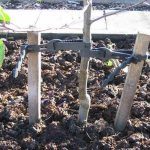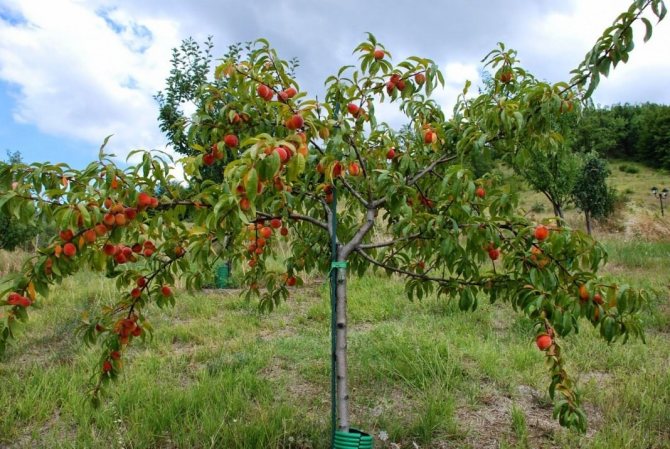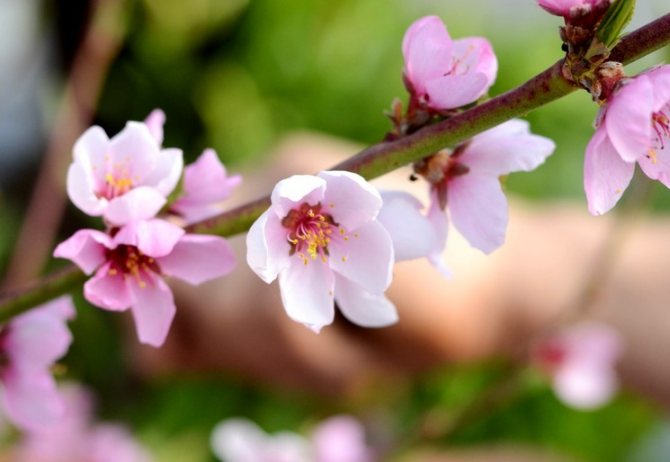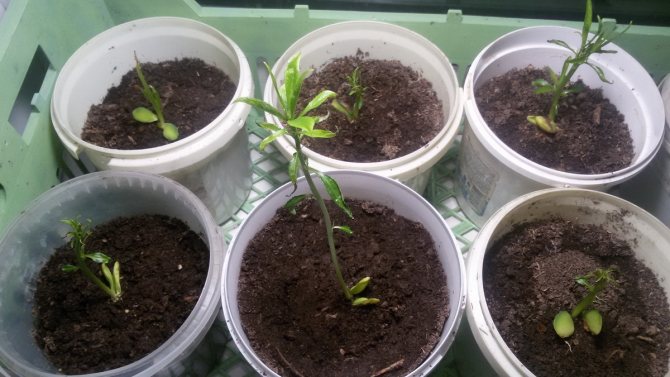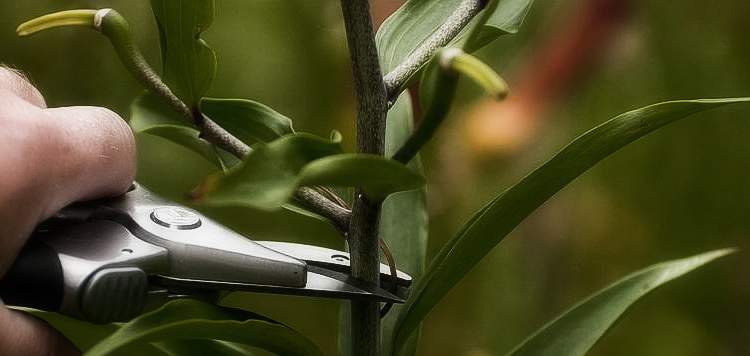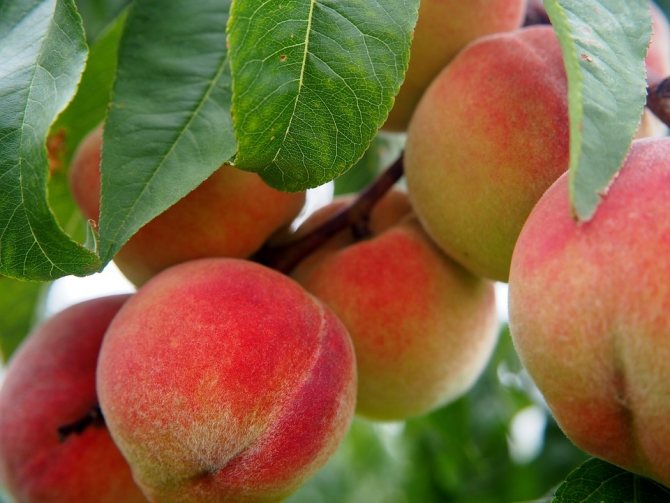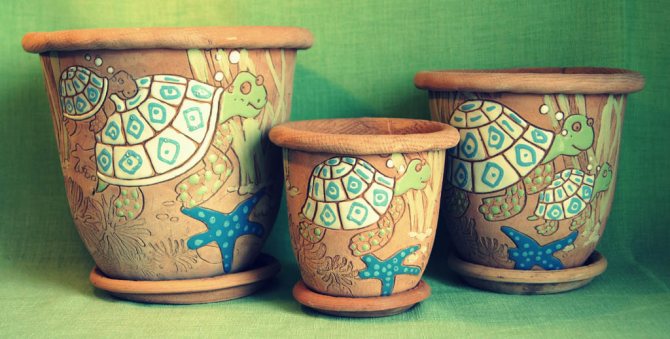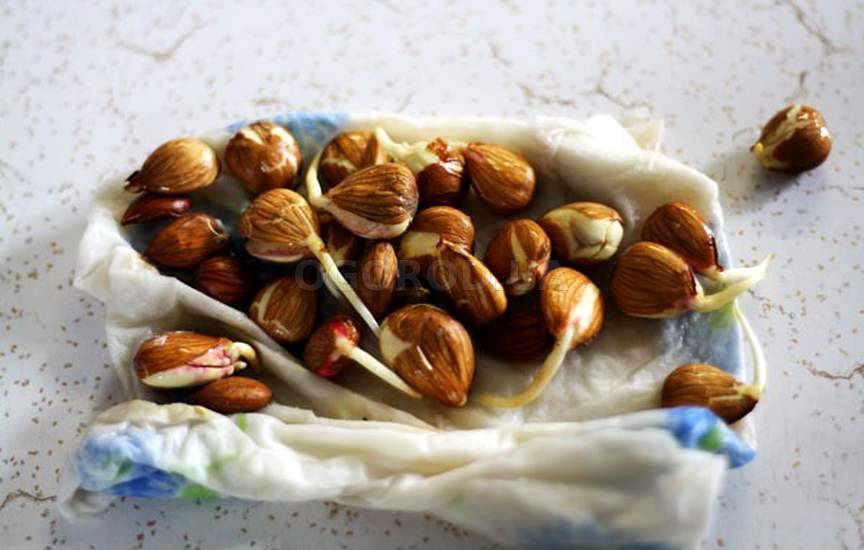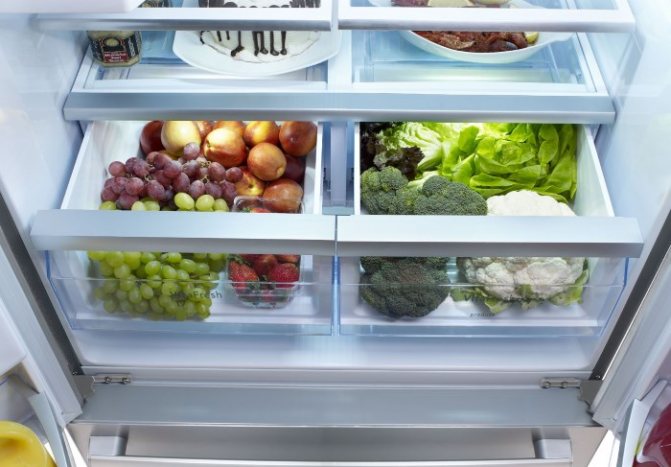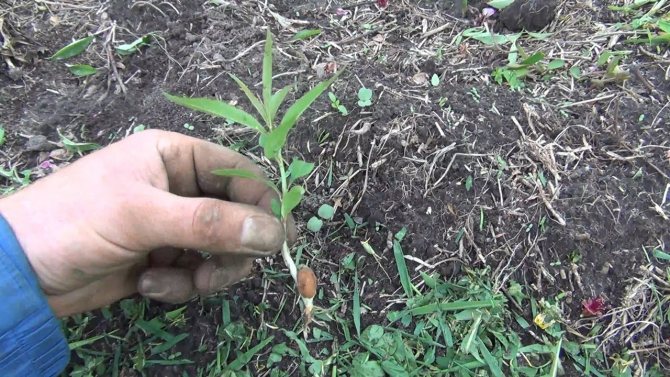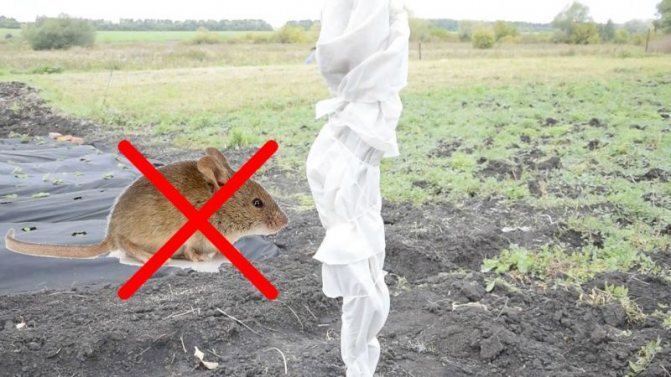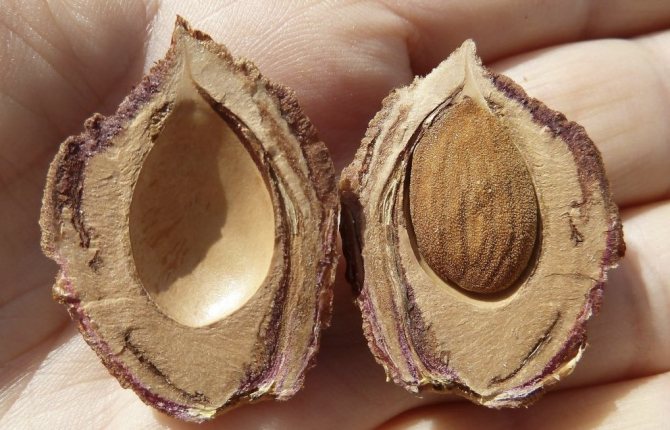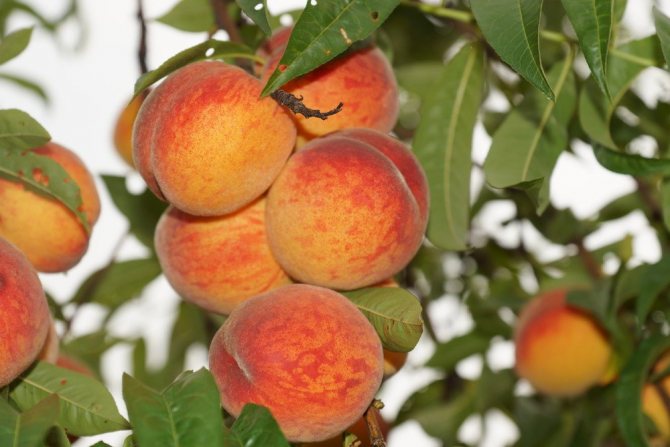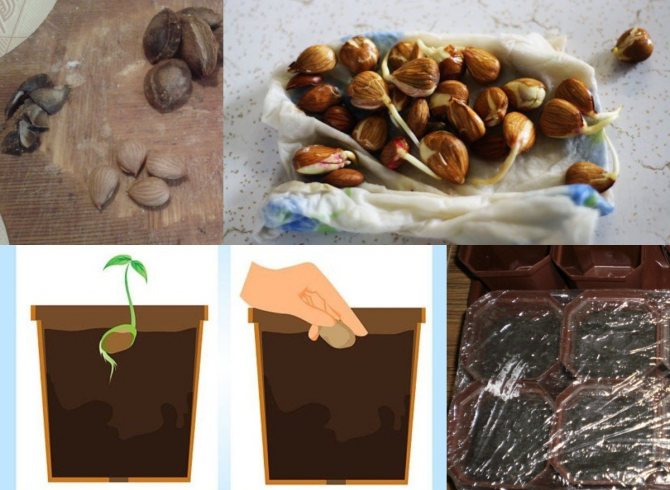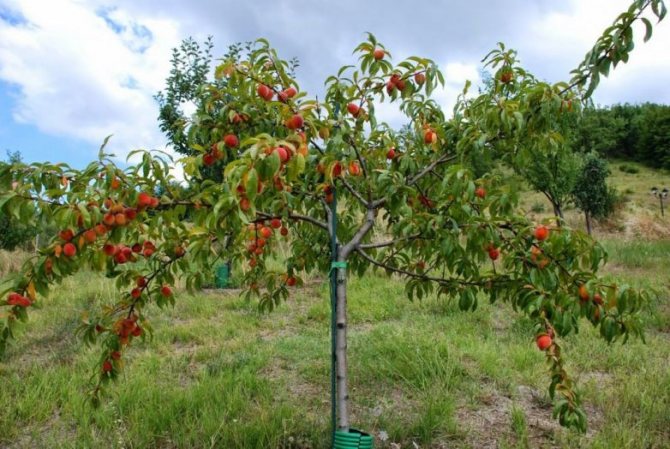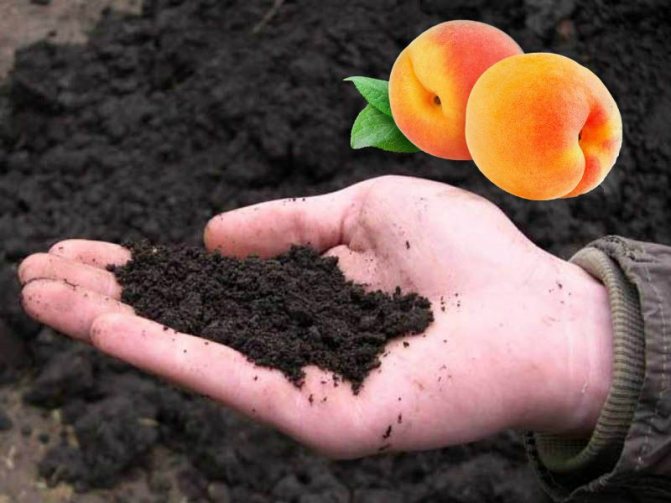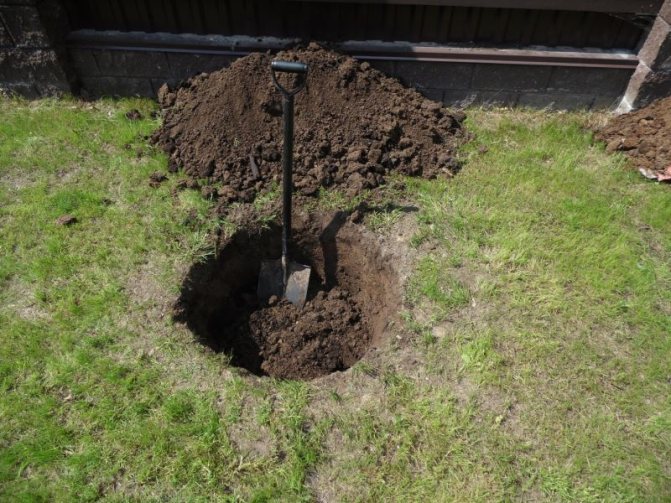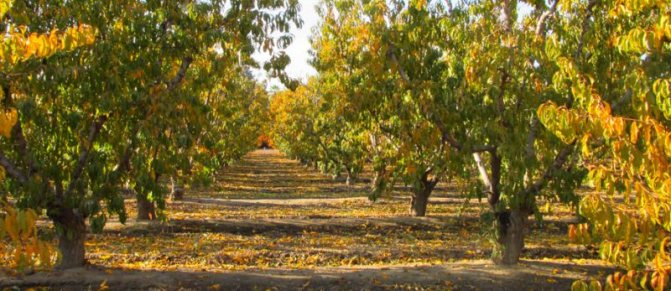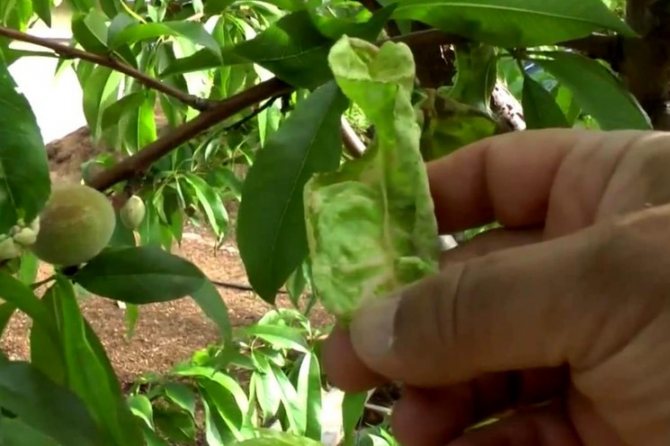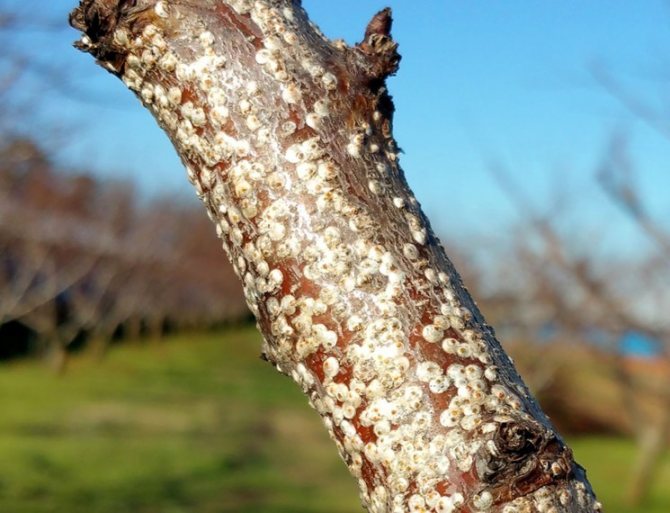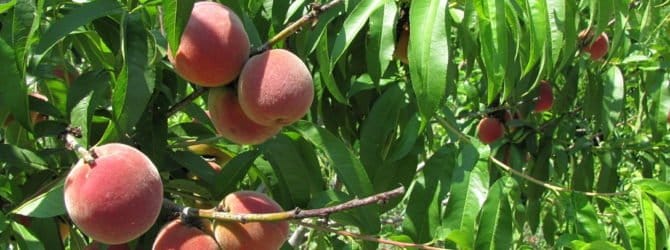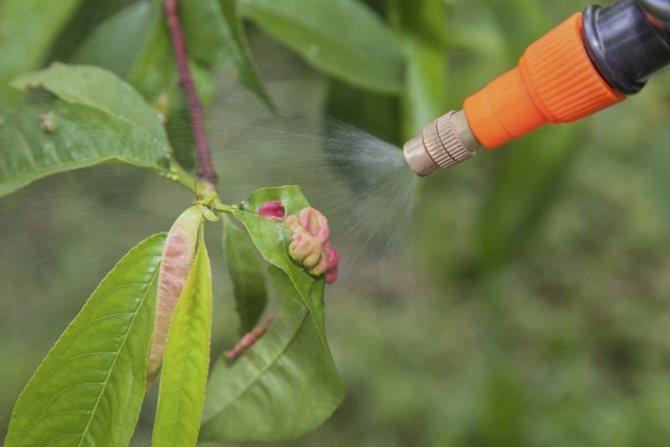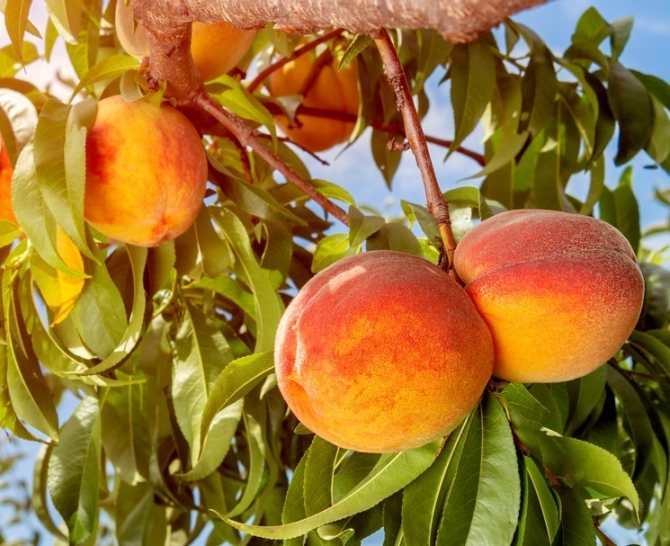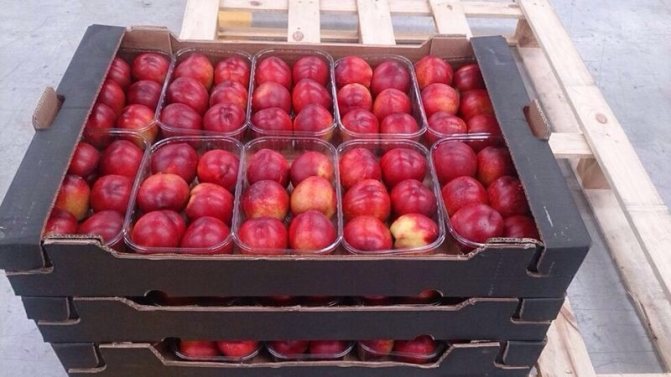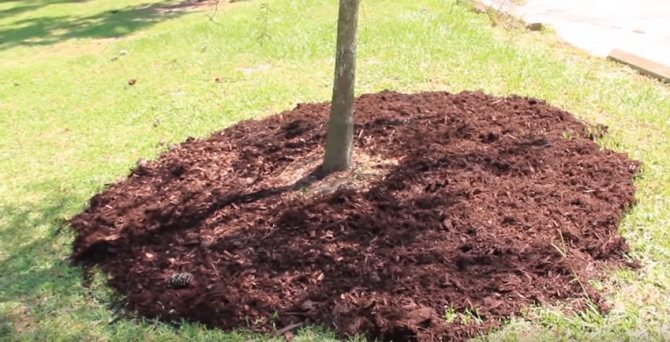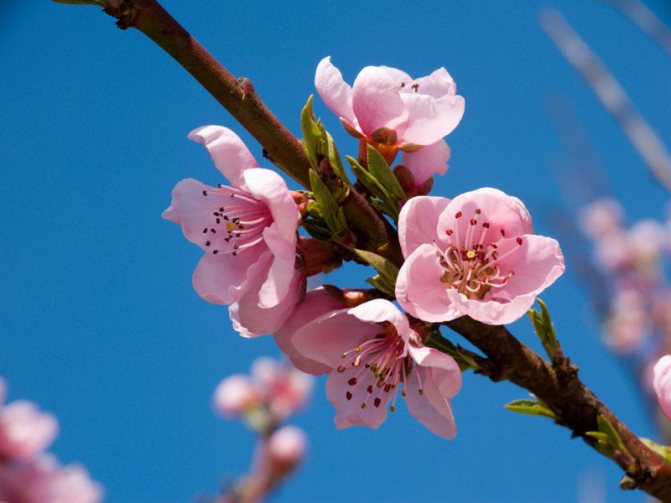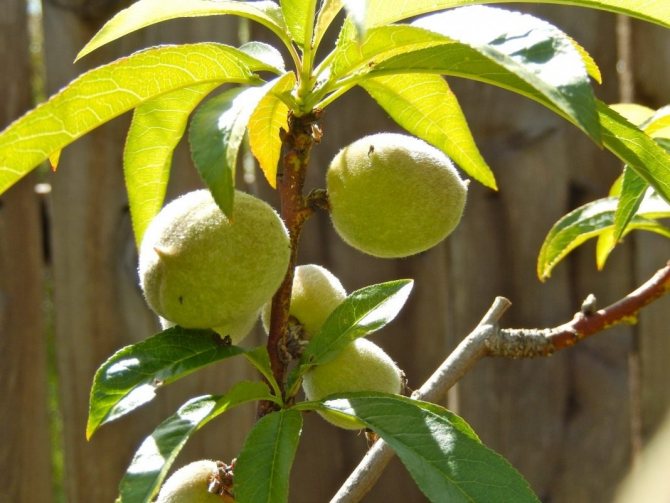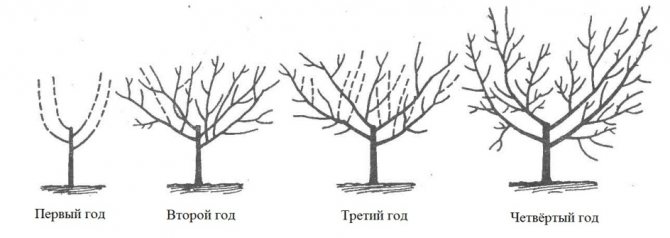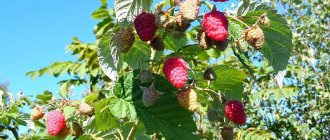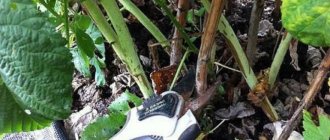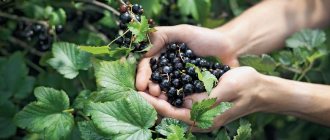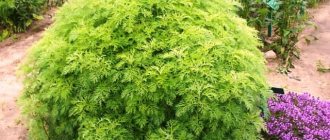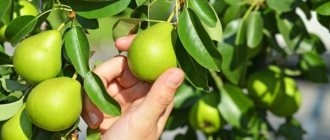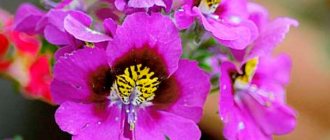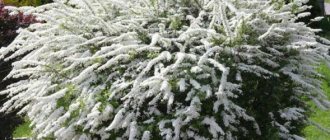Most gardeners say that planting a peach in the fall is a “bad deal” as they say. In fact, planting this crop in the fall can be quite successful. Moreover, if everything is done correctly, then the tree will not only take root, but also please with a rich harvest.
But how to properly plant this southern capricious woman, what are the optimal dates for planting, and how to organize proper care in order to harvest a good harvest every year, and we will consider below.
Peach tree - description
Peach
reaches a height of 4 m, and the crown diameter can be 6-8 meters. The root system of the tree is located close to the surface - a depth of 20-50 cm.
Leaves
lanceolate, finely toothed at the edges. Peach blooms in mid-April with pink or red flowers even before the appearance of a large number of leaves.
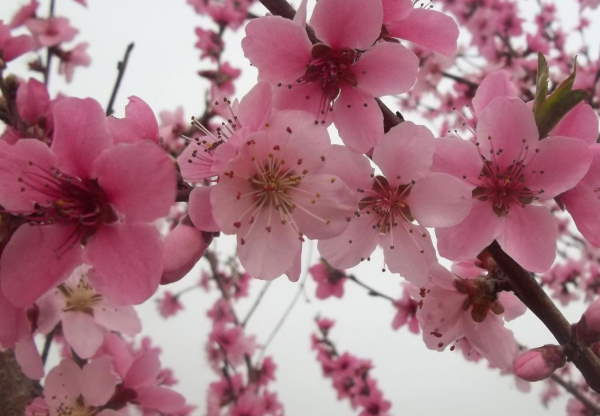
Peach fruit
can have various shapes - round, flat, elongated. Real peaches can be distinguished by softly pubescent fruits, and nectarines with smooth surfaces. The fruits are very aromatic, often with juicy pulp and extraordinary aroma.
Peach begins to bear fruit 2-3 years after planting and bear fruit for up to 20 years.
Choosing a growing method
Gardeners use three methods for growing peach trees from seed.
Stratification, or "cold method". An imitation of cold natural conditions is created so that the seeds are prepared for germination and germinate better.
During stratification, the shells soften, the seeds swell, complex organic substances turn into simple ones and are assimilated by the seed embryo.
Extraction of seeds. The “quick way”, which consists in splitting the bone and extracting the kernel. After the extraction of seeds from the stone, seedlings appear much earlier than during stratification.
Warm way. You can germinate seeds in pots at room temperature and natural light.


Gardeners use three methods for growing peach trees from seed: cold - stratification, warm and from extracted seeds
Cold way, or stratification, at home
For successful stratification, it is necessary to create moist conditions for seeds at a low above zero temperature and provide air access. For these purposes, a compartment for storing vegetables in the refrigerator or a basement is suitable.
Stratify seeds as follows:
- Prepare a small container, without a lid, filled with wet sand or peat. Use coarse sand, sifted out of foreign particles and thoroughly washed.
- Place the bones in the sand to a depth of 6-8 cm, place the container in a plastic bag with holes (to allow air to enter) and refrigerate for the winter.
- Check the container regularly and moisten sand or peat with a spray bottle if necessary. The main thing is not to overdo it with watering, otherwise the seeds may rot.
- In 3-4 months the seeds will "hatch" and sprouts of future peaches will appear.
- Remove the container of sprouts from the refrigerator and plant the seedlings in the pots. Take the pots with drainage holes. Use a fertile soil made from a mixture of leafy soil, peat, and humus.
- Place the seedling pots in a well-lit area.
- Avoid sudden temperature changes.At first, provide the sprouts with a temperature of + 10 ° C, placing them on a glazed balcony or veranda.
- After a few days, bring the pots with sprouts into the room and maintain the room temperature at + 18 + 20 ° C. Water sparingly as the soil dries.
What is stratification. How to do stratification correctly:
Chop and extract seeds
A quick way to grow a tree from seed for the impatient. If you do not want to wait until spring for the emergence of seedlings.
Proceed as follows:
- Chop the washed and dried bones with a knife or hammer. Work with tools carefully, try not to damage the core of the bone.
- Remove seeds and place in warm water for 2-3 days to swell. Replace fresh water daily.
- When you see that the seeds have swollen and increased in size, plant them in separate pots with drainage holes. Select the size of the pot taking into account the fact that the planting depth is 4-6 cm.
- After planting, water the seeds and cover the pots with glass or plastic wrap. Ventilate the "greenhouses" daily - remove the film, wipe off the condensation and let the pots "breathe" for a while. Remember, excess moisture causes mold and mildew to develop, which are damaging to seeds and seedlings.
- After the sprouts appear, remove the film.
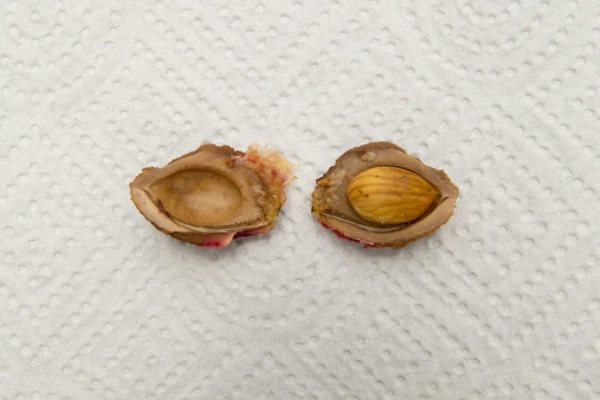

Remove the seeds and place in warm water for 2-3 days to swell, after planting, water the seeds and cover the pots with glass or plastic wrap
During the growth of the peach, the root system first grows, and only then the tree itself is formed.
Gardeners who grow peaches from seeds note that the height of the seedling reaches 0.5 m in 2-3 months.
How to germinate in a warm way
With this method, peach seeds are immediately planted in pots with soil mixture in the hope of waiting for sprouts to appear in a few months.
Planting technology is simple:
- Keep the prepared bones in the refrigerator for 6-10 days. This will be a kind of short-term stratification.
- Remove the seeds from the refrigerator and soak in a growth stimulant for 2-3 hours.
- Plant the seeds 6 to 8 cm deep in wet potting soil.
- Cover the pots with clear plastic or glass, ventilate them daily and wipe off condensation.
- Sprout peaches at room temperature by placing the pots on a brightly lit windowsill. Water as needed.
- When sprouts appear in 3-4 months, remove the film and move the seedlings to a well-lit place without drafts and direct sunlight.


Peach seeds are immediately planted in pots with potting soil, after holding them in the refrigerator for 6-10 days
Planting a peach
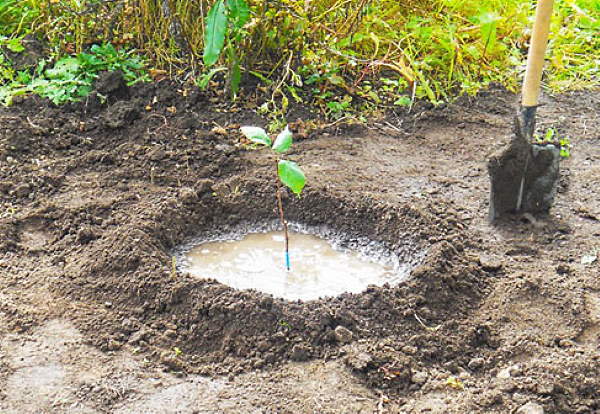

When to plant a peach seedling depends on the climatic conditions in your region. The farther south
you live means planting it is better to plant a peach in the fall.
In the northern regions
it is better to plant in the spring so that the peach seedlings get stronger and take root well.
In the central regions
the peach can be planted both in autumn and spring.
The site for planting peaches should be protected from the winds from the north side and located on the south side of the site, sunny, preferably on a hill. Place the peach 3 meters away from other trees.
Is it possible and how to properly grow a peach from a stone?
Choosing planting material
High-quality planting material is the key to success... Turkish or Spanish peaches, no matter how beautiful and tasty they are, are not suitable for planting in our latitudes.
Everyone knows that imported peaches are removed from trees long before biological maturity.This is the right approach, because with the onset of technical ripeness, fruits acquire a delicate taste, retain useful substances and tolerate transportation well over long distances.
But the seeds of such fruits do not ripen, and therefore you should not waste your time and energy on their germination.
Moreover, southern varieties will not survive in our climatebecause they are accustomed to more comfortable conditions. If the seeds sprout, then the seedlings themselves will die without receiving the required amount of sunlight and heat.


You need to choose peaches for pitting from zoned varieties, not from a grafted tree
If you have already decided to plant a peach, walk around the market looking for local fruits... A seller who has grown his goods with his own hands will be happy to tell you how to care for a seedling in order to achieve fruiting.
It's great if a neighbor in the country shares the harvest. In any case, prepare a few bones. The germination rate of peach seeds is about 25%, some of the seedlings will die during cultivation, so the more seeds you collect, the better.
Be sure to ask which tree the peaches were taken from. Do not take fruits from the grafted tree, because the characteristics of the variety when grown are unlikely to correspond to the mother.
Only peaches from a self-rooted tree give planting material that can preserve species characteristics.
Growing a peach from a stone is as easy as shelling pears:
Choosing a variety
Zoned varieties will feel better in a local climate, content with the amount of heat and lighting that the nature of a particular region can give them.
Even if you decide to plant seedlings in open ground, with proper care they will not be afraid of frosts.
When choosing a peach variety, pay attention to the main characteristics.
Winter hardiness. If you are planning to transplant a seedling into open ground, choose varieties with good winter hardiness and unpretentiousness to growing conditions.
Self-pollination. Many varieties are self-pollinated. But if you want to get a generous harvest, plant at least 3-4 peaches nearby, which will subsequently bear fruit.
Early maturity - for successful fruiting in summer, it is recommended to plant early ripening varieties (July-first half of August).
The most popular of the early ripe peaches are Early Rivers, Winner, Early Minion. Good winter hardiness in Amsden and Kievsky early varieties, and high yields in White Nectarine, Krasnodarsky Nectarine, Redhaven and Nobles.
To remove the seeds, prepare large, ripe, soft fruits with no signs of damage, rot or mold. Free the bones from the pulp, rinse thoroughly under running warm water and dry. Select seeds without traces of pests and cracking.
How to plant a peach in spring
Prepare in advance a landing pit 40 x 40 cm and a depth of 40 cm. Mix the top layer of soil from the pit with a bucket of humus, add a glass of ash, 100 grams of nitroammophoska. If the soil is fertile, add only ash and mineral fertilizers when planting.
Before buying seedlings, check with the seller how they are adapted to your area.
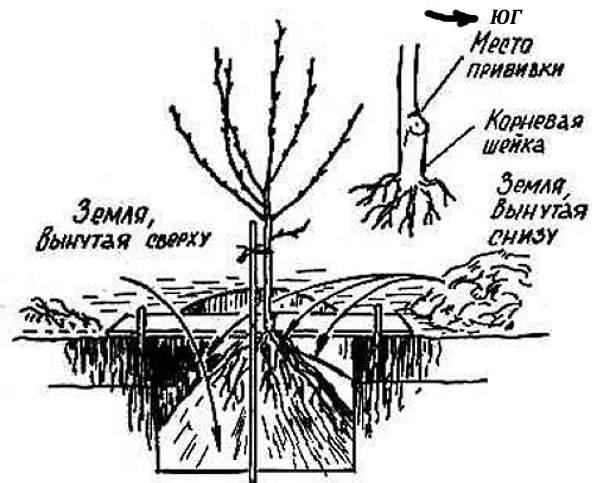

In the center of the hole, pour a hill and set the root system of the seedling on it and sprinkle it with earth, first measure the depth of planting of the seedling - the grafting site was 3 - 5 cm above ground level.
It is also necessary to observe one more rule - the place of the cut on the vaccination must be directed to the south, that is, the shoot that has grown from the vaccination must be sent to the north when planting (for more details, see the video below).
The planted seedling must be tied to a peg, made a near-trunk circle and poured with 2 buckets of water. As the water is absorbed, mulch the soil with peat or organic matter. Cut the peach seedling, leaving a height of 70-100 cm.
Video - PEACH. Basic rules for planting seedlings
Transplanting peach seedlings to a permanent place
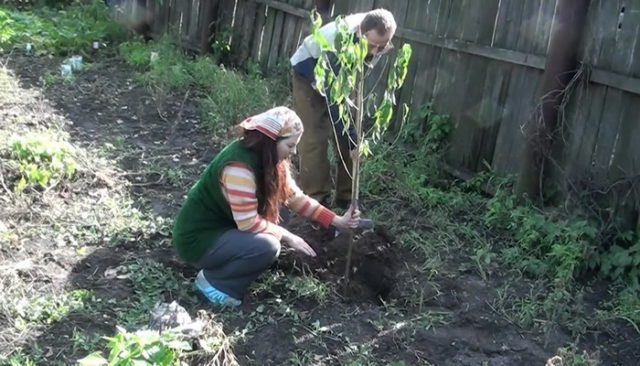

Growing seedlings in pots lasts 1 season. From the second year of life, it is advisable to transplant peaches to a permanent place. A similar procedure is resorted to if dense crops were originally grown in open ground. The best time to transplant is early spring. The hole is dug with a margin so that the root system can fit freely. For backfilling, use soil mixed with earth, peat and compost. The root collar is left not buried - at ground level. After filling, the seedling is watered, tied to a peg. The soil around the trunk is covered with mulch.
Peach - care in spring
At the beginning of April, peach care begins - the very first thing is to process the swollen buds from pests and diseases.
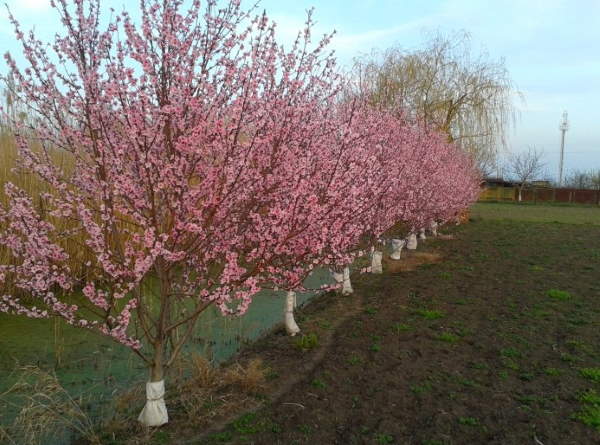

To protect against fungi and as a prevention of the appearance of curly leaves, peaches are treated bordeaux liquid
(such treatment is carried out at the very beginning of the season on swollen buds, it is prohibited during the growing season).
After flowering, a second treatment for pests and diseases with chemicals is also carried out.
Of pests
the most dangerous are spider mites, aphids, scale insects, moths.
Common peach disease
- curliness of leaves, powdery mildew, gum flow, moniliosis.
After a winter with little snow, water the peach in the spring.
Video - Real Bordeaux liquid
How to plant a peach tree. Planting peach seedlings by region
The cultivation of peaches in suburban conditions is somewhat different from cultivation in industrial quantities, mainly in terms of protection from diseases and pests.
Peach is a southern plant that belongs to warm and sun-loving crops. The crown and root system freeze over at frosts of -15 ..- 20 ° C. With returnable spring frosts, last year's growth freezes over, but quickly recovers. Peach grows and bears best in areas with a warm climate and a lot of sunny days a year.


Planted peach trees.
Southern regions
In the southern regions, it is more advisable to plant peach seedlings in the fall in September-October. Weather conditions allow the seedling to adapt to a new planting site before the onset of cold weather, overgrow with young roots, prepare for an active life with the onset of spring.
If peach seedlings are planted in the south in the spring, they are most often exposed to the hot May-June sun. Dry air and sun rays dry out the kidneys, the bark and subcrustal layers coarse and dry out. To save the spring planting (and at this time there is a lot of other work in the garden and in the garden), you need to protect the peach seedling from the sun's rays with any breathable shelter, spray it with water (not cold), and keep the soil constantly moistened, that is, water it 2 once a week. Over time, the shelter is removed, watering is transferred to a one-time per week and young leaves are sprayed with zineb or 1% Bordeaux liquid. When planting in autumn, blossoming peach leaves are also sprayed with this composition. This technique prevents the appearance of curly leaves.
Regions of the middle and northern strip
In the middle lane, peach seedlings can be planted in autumn and spring, focusing on the state of the weather. With the onset of early cold weather with prolonged rains, it is better to dig in the seedlings and plant them in the spring, as soon as the spring frosts have passed. The soil in the upper layer should warm up to + 12 .. + 15 ° С.
To the north, frost-resistant peach varieties normally take root only during spring plantings. Moreover, there is no need to rush to plant young trees early. The soil and air should warm up enough. Having strengthened during the spring-summer period, peaches more easily endure the winter cold in the middle regions and the northern regions adjacent to them. When grown in cold areas, peaches are sheltered for the winter.
Peach - summer care
The main activities during this period are to distribute the load of fruits on the branches of the tree.Leave one fruit on each branch for a length of 8-10 cm, remove the rest.
In the tree trunk circle, either mulch or loosen the soil and remove growing weeds.
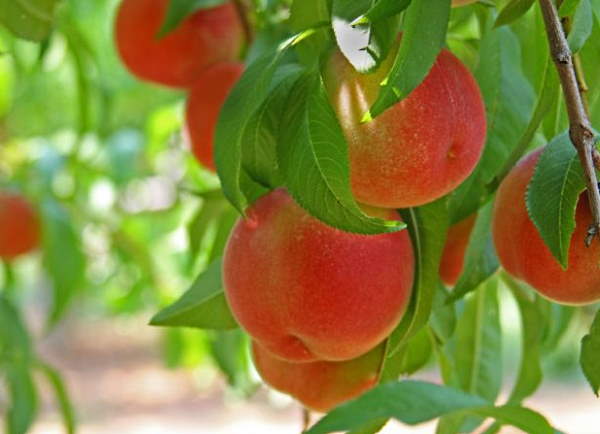

During the prolonged heat period, the peach needs watering. Also, a month before the harvest ripens, carry out the last treatment for pests and diseases.
Video - Secrets of growing a LARGE peach
The benefits of peach
Sweet-sour, honey-sweet peach pulp, delicate and aromatic, is not only tasty, but also curative. These fruits are high in vitamins, sugars, pectin and organic acids, including cinchona, tartaric, citric, and malic acids. Pectins and antioxidants protect the body from aging. The high content of vitamins of the group "B", A, PP, K, C, E, a fairly large list of minerals, including potassium, magnesium, iron, copper, calcium, sodium, zinc, fluorine, manganese, selenium, silicon, chlorine, phosphorus, aluminum, sulfur, help to resist various diseases, including anemia. Peach juice is prescribed by doctors for anemia and heart rhythm disturbances, gastrointestinal diseases, neurodermatitis, asthma, flu and many other diseases. The iodine contained in peach fruits helps to normalize the thyroid gland, which is responsible for the body's immune system. Peach oil is obtained from the seeds, which is used in the manufacture of cosmetics and medicines.
Watering the peach
During the entire growing season, the peach must be additionally watered 2-3 times, but it all depends on the weather conditions in your region. At one time, up to 50 liters of water are poured under the tree (it all depends on the age of the tree), watering in the evening or early in the morning. The main thing is that when watering, the soil is soaked to the root level of 60 cm.
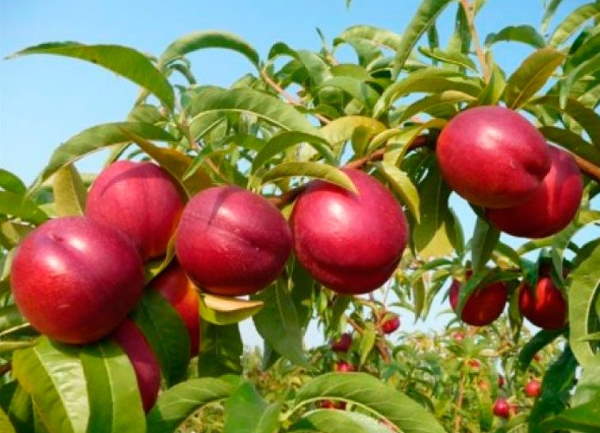

A month before harvesting, water to increase the weight of the fruits, after which watering is no longer carried out until the harvest itself.
In the fall, water-charging irrigation is carried out up to 100 liters under a tree.
Leaving after disembarkation
The most common and frequent mistake of almost all novice gardeners is that after planting a peach crop, they do not pay enough attention to the tree and leave almost all lateral shoots on it. Gardeners hope that this method will bring more harvest.
In fact, a large number of lateral shoots, on the contrary, can destroy the culture. The fact is that in the spring, the entire ground part of the tree begins to evaporate moisture, which is very important for the root system of an immature plant.
As a result, moisture does not have time to be replenished, which leads to overdrying of the roots. In order to prevent the appearance of such a problem, it is recommended to perform the following manipulations:
- after planting the peach, it is necessary to determine the three strongest lateral shoots, and shorten them by ¼ part;
- the remaining lateral branches should be completely excised;
- then all the cuts are treated with crushed activated carbon, and a layer of garden varnish is applied on top, which will help protect the plant in the winter.
After completing all these manipulations, do not forget to whitewash the tree with a solution of slaked lime. A layer of whitewash will help protect your plant from frost damage. And the final stage, the shelter of culture for the winter. In fact, caring for a peach is not difficult if you strictly adhere to all recommendations.
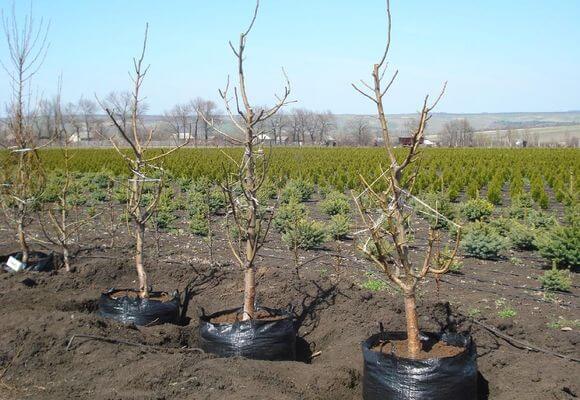

We cover the seedling before wintering
As you know, the peach culture is southern, and therefore very capricious. Therefore, before wintering, you should thoroughly cover the tree so that severe frosts cannot damage the plant.
At the same time, always remember one rule: to cover a peach, you can use any material that allows air to pass through well. But polyethylene is strictly prohibited to use.
There are two ways to cover the peach culture, namely:
- Prepare burlap for future use, which is then wrapped around the stem of the culture. And after the tree is wrapped, 20 cm high earth is poured around the trunk from above.
- The second option is to stock up on a large cardboard box that you put on a tree, and do not put a layer of straw or hay underneath.
Both options are simple and very convenient. At the same time, do not forget, as soon as the first snow falls, take a shovel and throw snow over the crop, such a kind of blanket will serve as a good protection for peach trees even in the most severe winter.
Peach feeding
The first top dressing in the spring can be spraying trees on dormant buds with a urea solution - it will provide the tree with nitrogen and destroy insect pests remaining in the bark and on the surface of the soil under the tree.
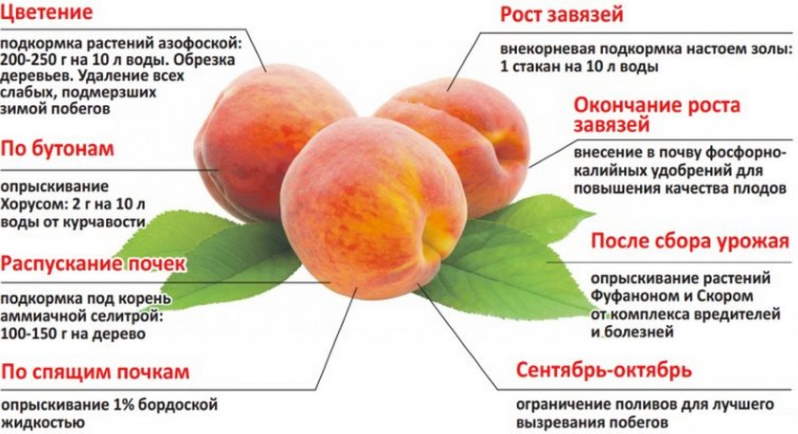

If you are late with urea feeding, then loosen the soil under the tree with the introduction of 70 grams of ammonium nitrate for a young seedling, older trees need 20 grams more fertilizer.
After flowering, feed with complex mineral fertilizers, for example, nitroammofosk 50-70 grams under a tree. The tree also responds well to foliar dressing with fertilizers with microelements.
In the fall, digging up the soil into the trunk circle, 50 grams of superphosphate and 100 grams of ash are introduced (can be replaced with potassium fertilizers - potassium chloride, potassium monophosphate, potassium sulfate).
Once every 3 years, organic fertilizers - humus or compost can be applied to the trunk circle.
How many times should the peach be repotted. Peach - is it worth replanting?
Traditionally, the optimal age for transplanting a garden pet, a doggie is considered to be up to five to seven years old. Whiter adult plants tolerate habitat change incredibly hard, which can lead to rapid deterioration or even death of the tree itself.
It is recommended to transplant peaches in late autumn, after digging the plant about one meter wide and eighty centimeters deep in the soil.
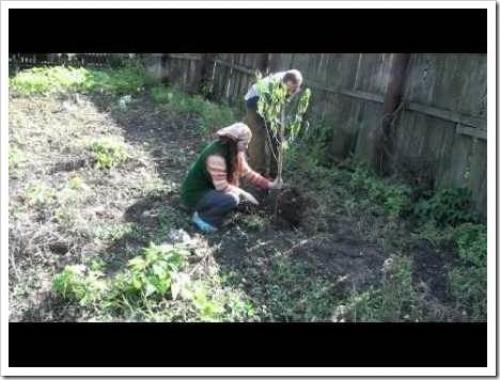

Thus, you can create the most comfortable conditions for transplanting and avoid serious loss of the existing root system.
If you decide to transplant the peach earlier, choose a calm, cool day. Late evening will be the best time for the procedure, which you will need to complete within a few hours without prolonged breaks.
For transplanting, you will probably need several assistants who can provide an optimally fast digging procedure. Try not to chop the plant off your shoulder, protecting the root system from unnecessary and unnecessary damage.
An excellent option for the plant would be to preserve part of the "native" soil on the dug roots, this feature will help the tree to transfer more easily and will become the key to the viability of the peach in its new habitat.
A great way to protect the roots of the tree will be a special bandage made of burlap or polyethylene. Gently tie up the roots of the plant, protecting the soil dug out during extraction.
The new residence of the peach must be prepared in advance. To do this, it is recommended to dig a hole that coincides in overall dimensions with a hole under a tree formed in the old place.
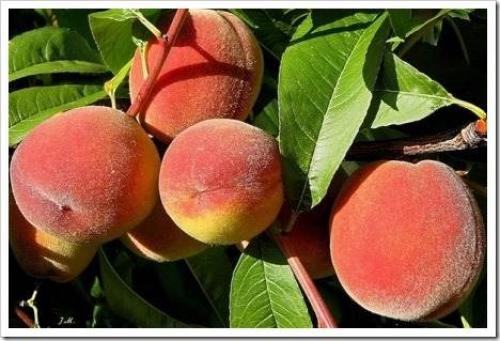

Thoroughly grind the soil at the bottom, sprinkle the place with trusts of ash and one hundred grams of slow-acting mineral fertilizers. It is also recommended to place a layer of existing compost at the bottom of the pit and fill in water, so that the preliminary watering is thorough and abundant.
Carefully remove the bandage and place the peach in the prepared and fertilized well. Then proceed according to the traditional scheme when planting fruit trees of this type.
When transplanting a peach, it is recommended to prune the ground branches of the tree, this will contribute to a logical equalization with the loss of the root system that occurred during the digging procedure.
Try not to prune in the summer and get ready for a laborious and very difficult procedure: after all, transferring an earthen coma on the roots of an adult plant is not an easy job.
Peach shelter for the winter
At a young age, it is better to cover the peach for the winter. To do this, next to the tree, 2-3 sticks are hammered like a tree in height and wrapped in burlap, agrofibre. It is also necessary to cover the tree trunk with burlap or cardboard.
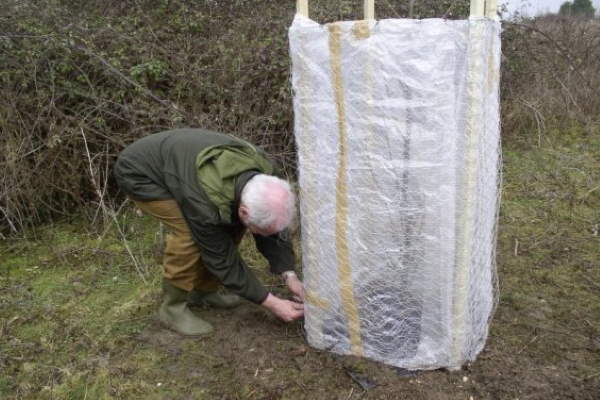

If you have mild winters, then you can mulch the trunk circle with peat to a height of 10-15 cm.
Choosing a seedling
No matter how favorable the climatic conditions for growing a peach, it is naive to believe that growing a healthy tree will come from any planting crop. To get good harvests on a regular basis, you need to choose the right seedling. How to do it? Consider below:
- The tree of this culture is best purchased at a local nursery, which has proven itself well.
- Inspect the seedling carefully before purchasing. Make sure the tree is dormant. This can be determined by the following signs, the shoots are completely covered with bark, and the buds are fully formed.
- Buy peach varieties that are adapted to your region. By the way, experienced gardeners are advised to buy the planting material that was bred in Ukraine.
- If you are a novice gardener, then it will be optimal for you to purchase planting material that is two years old. The height of such material will be 5 meters, and the thickness of the trunk will be 2.5 cm. At the same time, the young growth should have at least 4 branches.
And, of course, pay attention to the appearance of the planting material. He must be healthy and strong. If the foliage of the tree is wrinkled, and the bark is peeling, then it is better not to acquire such a tree. Since the chances that it will take root are small.
Peach pruning
The best time to prune a peach is in spring, when the pink buds appear and before they bloom. In the fall, only sanitary pruning of broken and dried branches is carried out.
From the first year of life, it is necessary to start forming a peach, thanks to which the peach will begin bearing fruit earlier, it will be convenient to harvest and take care of the tree.
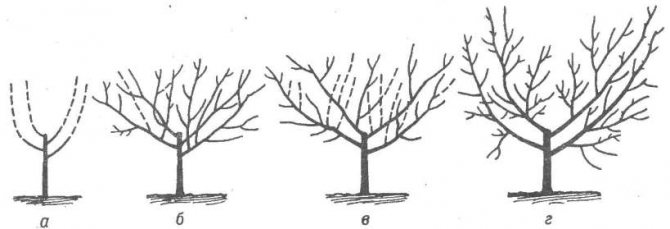

Trees of different ages need to be pruned in different ways. A seedling planted in spring is cut at a height of 70 cm and then formed in the form of a bowl. Outgoing branches are pruned to the sides to 15 cm on the outer bud. Strong top growths are removed.
Autumn landing
So, how to properly plant a peach in the fall? First, let's figure out what is the optimal time for this procedure. As a rule, peaches are planted in autumn in early September. To do this, choose a place located on the southern side of the site.
If you plan to plant several seedlings at once, then the distance between them should be at least three meters. If it is possible to plant a given culture against a wall or fence, then this will be the best option. Since such an area is well protected from strong winds and is fully illuminated by the sun.
It is also very important to prepare the land for planting a peach crop. This procedure is performed a week before the planned disembarkation, namely:
- first, the site is thoroughly cleared of weeds and other debris;
- then, the zone is dug up and rotted humus is introduced into the ground together with phosphate preparations;
- the prepared soil should stand for a week, and only then can the peach be planted.
After completing all these simple manipulations, you can start forming the planting holes and preparing the seedling. At the same time, it will be useful to emphasize that even a bone can sprout if you plant it correctly and organize its care.


Planting pit preparation
If you want your peach to take root, you need to properly dig and prepare the planting hole. To do this, perform the following manipulations:
- dig a hole 80 cm deep and 70 cm wide;
- then, 30 liters of warm settled water are poured into the finished pit;
- then a layer of broken red brick is laid out on the bottom of the hole, which will serve as drainage;
- further, it is necessary to add a bucket of rotted humus mixed with earth and wood ash to the hole.
Having completed all the above manipulations, they begin to plant a peach culture. The disembarkation is performed as follows. First, a wooden rail is installed in the very center of the hole. Next, the peach is planted.
The trunk is neatly installed in the center of the pit, so that the tree fits snugly against the rail. Then, it is necessary to evenly spread the root of the culture and sprinkle it with earth. After the planting is completed, the peach trunk is fixed with twine to the rail. And the final stage, abundant watering of the culture with a bucket of warm water, and the introduction of mulch.
It should be noted that the mulch layer should be at least 15 cm.
This kind of protection will help protect the root system in the winter. Well, as for the mulch itself, the following components are used for this:
- dry straw or hay mixed with rotted humus;
- chopped pine bark;
- dry leaves;
- agrofiber.
Experienced gardeners recommend using the first option, since this mixture performs two important functions. The planted culture will be protected from severe frosts, and at the same time it will be fed with useful elements.
Features of cultivation in different regions
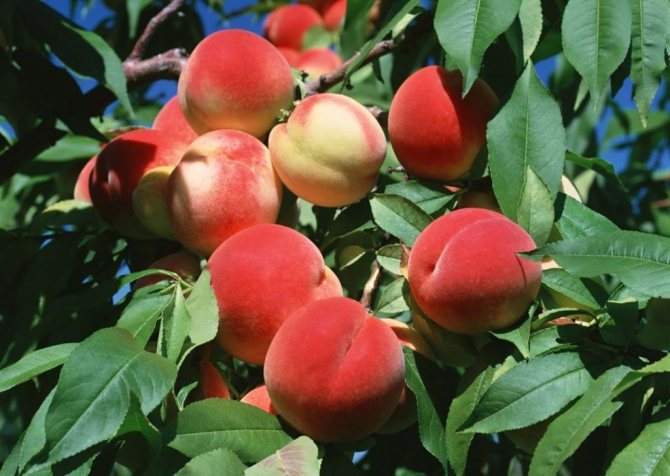

The main problem in growing this crop is wintering.
Most peach varieties die already at a temperature of -20 ° C. More winter-hardy varieties tolerate temperatures down to -27 ° C for buds and -35 ° C for wood.
However, these figures are considered by many gardeners to be overly optimistic, therefore, even in regions with more or less warm winters, they try to cover the peach for the winter, if possible, somehow.
back to menu ↑
See also: Peach: description and characteristics of the 15 best varieties. Early, mid-season and late varieties + Reviews
Regions with warm climates
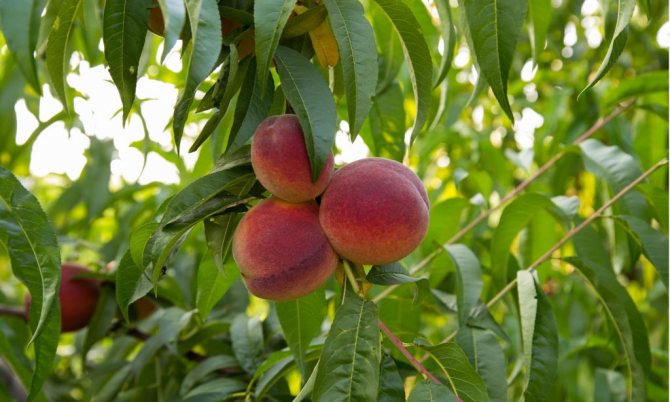

Growing peaches in Moldova
Without changing the standard "layout" of the tree (bole and several skeletal branches), the culture can be grown only in the south of Russia, Ukraine and in the south-west of Belarus.
The regions in which the peach feels relatively well in the form of an ordinary tree include: Kuban, Rostov region, Astrakhan, Caucasus, Kherson, Nikolaev and Odessa regions in Ukraine, as well as Brest region, located on the territory of Belarus.
back to menu ↑
See also: Plum - a description of the 22 most popular varieties: yellow, rennlode, Hungarian and others + Reviews
Growing in the Middle Lane
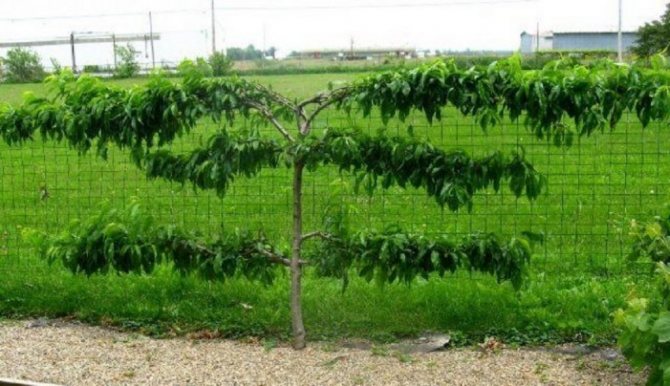

Growing peaches on horizontal trellises in cool climates
Central Russia, the Moscow region, the regions of the Chernozem and the Volga regions - these are already risky areas for the cultivation of classic peach trees. Of course, you can wrap the trunk with several layers of thermal insulation for the winter, and hang protection from a special heat-insulating tack on the crown, but this will take a long time, and besides, this method is not cheap.
In such regions, peaches are grown in the form of low boles with 2-3 rows of branches on each side of the trunk. It is much easier to protect such a structure from frost and other environmental factors (in particular, from strong winds).
The crown of this method of formation consists of 4-6 branches, which should be placed as close as possible next to each other. The optimal distance is 20 cm. Every year, at the beginning of spring (best before the time of sap flow), cyclic pruning of trees should be carried out.
It is done in the same way as grapes: several upper annual branches are cut at distances of up to 30 cm, and the lower branches located under them - by 10 cm.Accordingly, if there are six branches (three rows each), the upper one is cut off by 50 cm, the middle one by 30 cm, and the lower one by 10 cm.
In order to avoid overgrowth, in the middle of summer they pinch all young branches that have reached 10-15 cm above the outer bud. In addition, all excess growth that appears on and around the trunk is removed. If a branch develops faster than others, it is shortened into two buds, etc. It is this method that guarantees the best fruiting and restoration of fruiting branches.
Sometimes a slightly different scheme is used - the branches are not allowed to run parallel to the ground, but at an angle of 45-60 °, for which for 1-2 seasons they are tied to stakes driven into the ground. So, although the bush is "driven" upward, the tree itself takes up less space.
back to menu ↑
See also: Date palm: features of growing from a stone at home, transplantation and care | (50 Photos) + Reviews
Growing in cold regions
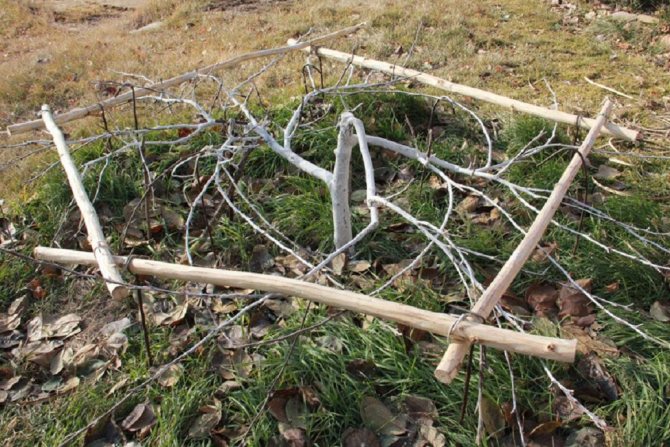

Peach shale
In harsher regions, things are even more difficult. Here it is necessary to cover the plant completely, bending its branches and trunk to the ground. Peach wood is fragile, so growing it in the form of a tree or a low trunk is out of the question. For cultivation in Siberia (Chelyabinsk region, Khabarovsk Territory, etc.), the so-called. stanza form.
For this, the branches of the tree, starting from a young age, are literally allowed to creep along the ground. At the same time, young shoots, on which generative buds appear, are about 1 m long and grow perpendicular to the soil level. Because they are flexible enough, they can be easily bent to the ground for winter cover. Despite such an unusual design, stanza forms give bountiful harvests and have good resistance to summer cold and winter frosts.
There are two types of stlanes: Krasnoyarsk, in which the main trunk has a short length and is located perpendicular to the ground; and the Minusinsky elite, located at an angle of 45-60 ° relative to the ground.


Peaches in a greenhouse in the Urals
Usually, the stanza is formed according to the following scheme:
- for planting, frost-resistant varieties are chosen that do not have high yields, but have good endurance
- seedlings are planted in open ground and pinched at a height of 15-20 cm to form branching
- in subsequent years, branching is allowed parallel to the ground level
- in the future, these branches will play the role of rootstocks, on which cultural peaches should be grafted, which are a kind of shoulders of stanza
- grafting is carried out at the beginning of the season, so that by autumn the shoots have grown enough, and they can be bent to the ground for wintering
In this form, the elite is supported all the time of fruiting. As the stock grows, new cultivated grafts are grafted onto it - this agricultural technique allows the stlanx to grow in width and height.
The stanza is covered in several layers: the branches are first sprinkled with a layer of sawdust or straw, and on top they are covered with agrofibre or ordinary polyethylene. The outer layer is earth or fallen leaves.
In the spring, the covering material is not removed immediately, but gradually. First, the outer layer (ground or leaves) is removed and only after 2-3 weeks, as soon as the temperature permits, the peaches are finally freed from thermal insulation.
back to menu ↑
See also: Apricot: a description of 20 popular varieties, planting in the middle lane, care features (33 Photos & Videos) + Reviews
Growing at home
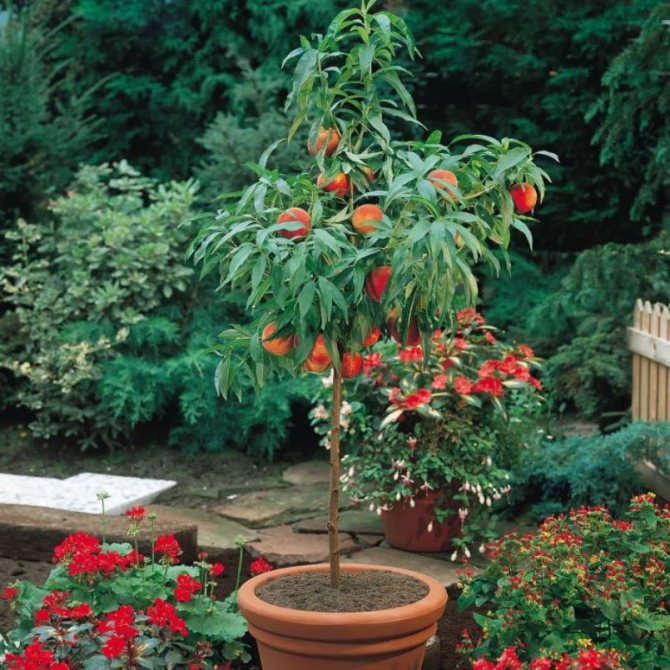

Potted peach at home
As such, the peach can be grown almost anywhere. The living conditions, although they impose some restrictions on the size of the tree, still make it possible to receive, albeit small, but stable yields from season to season. Usually, such a tree bears fruit for 5-7 years.
But the main purpose of growing a peach at home is this is getting seedlings by seed propagation of a culture.To obtain a larger amount of seed material with this method of propagation, it is recommended to keep the seedling not in the open field for the first two years, but in more gentle conditions.
In addition, it is sometimes difficult to predict the moment of seed germination and a young plant may not have time to plant in open ground before the onset of cold weather. After overwintering in a tub or pot and gaining strength, a seedling planted in open ground in spring will take root perfectly.
back to menu ↑
See also: Perennial asters: description of 13 species, care and planting at home, methods of reproduction and growing from seeds + Reviews
Planting dates for peach pits
In room conditions, the seeds are planted in seedling containers at any time of the year, but at a stationary location - they are transplanted into open soil mainly in the fall. On the territory of central Russia, this time falls approximately at the beginning or middle of October, but for the southern regions, a November landing is also allowed. In any case, it should be a sunny, clear and fine day with moderate humidity.
Video: Growing a peach from a stone is as easy as shelling pears
Conditions for stable fruiting
A tree grown from a bone will have good immunity. If the plant does not die at the very beginning, then subsequently it will not be afraid of any unfavorable weather conditions.
The peach grows rapidly, in the first year it stretches up to 0.5 meters, in the second - up to 1-1.5 meters. The culture will begin to bear fruit somewhere in the 4-5 year of life. In order to get a good harvest, you need to correctly form the crown in the early stages and apply top dressing annually. During the dry season, the peach needs to be watered.
Tips and tricks from experienced gardeners
The peach, according to gardeners, has a difficult character. Nothing affects its yield like correct pruning and regular feeding. The fruits ripen on the side branches, so the center of the tree should be open.
If the variety grown from the seed turned out to be small and sour, the tree can be used as a rootstock. By the method of budding or grafting, you can graft a stalk or eye of a cultivated plant into it.
Peaches are harvested as they ripen - in July-August. It is better not to store the harvested fruits for a long time, but to preserve them. Jam, compotes are made from peaches, they are dried, added to desserts.
Rules for choosing a suitable planting material
For successful reproduction of a plant, you need to know which seeds to choose. Store-bought fruits are not suitable for this event:
- fruits were brought from very warm countries (Turkey, China, Italy) and trees from them will not be able to acclimatize in Russia;
- the fruits are harvested at the stage of technical ripeness for long-term transportation, the nucleoli in them are not ripe;
- fruits are treated with chemicals to extend the storage time, because of them the seeds become brittle and often crack.
You can grow a peach from any fruit. But in the garden, the seedling will die because of the local climate unsuitable for it.
Important! For propagation of a peach with a bone, they buy fruits grown in Russia. And the closer the peaches grow to the future planting site, the better.
Growing a fruiting peach from a stone at home is a laborious, but very interesting process. These trees are best adapted to local conditions.


If it is possible to get peach seeds of winter-hardy early varieties, then success is guaranteed. Such varieties, growing in the southern regions of Russia without shelter, and in the Moscow region with shelter, include:
- Kiev early - a low tree of 3 meters in height. A distinctive feature of the variety is quick recovery after frost damage. Fruits weighing 80–90 g ripen in early August and have greenish-white flesh.
- Early Pushkin - the tree grows up to 6 m in height. Fruits weighing 100-120 g ripen at the end of August and have a greenish-creamy flesh.
- Redhaven is an old American cultivar that grows to a height of 5 m.At the end of August, large fruits, weighing 140–160 g, ripen with an orange-yellow core and pink stains in the center.
The seeds of these varieties are best suited for cultivation in the central regions of Russia. Propagation by seeds does not repeat the varietal characteristics of the parent plant, but the seedlings are the most adapted to local climatic conditions.
Which peach pits are suitable for planting
For planting, seeds from healthy peaches are selected. The fruits should be fully ripe, soft, with a whole skin, without dark spots. It is recommended to buy local fruit from the market to ensure that the fruit is ripe on the tree.
The original plant must be a variety: hybrids do not convey maternal qualities. This can also be obtained from the seller in the market.
The bone must be intact, free from insect damage and cracks. It is important to remember: easy separation of the bone from the pulp is a varietal feature, and not an indicator of the ripeness of the fruit.
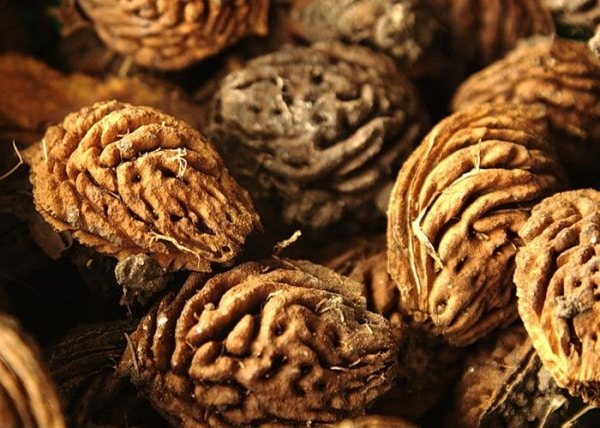

Choosing a place on the site
Peach loves the warmth and abundance of sunlight, to which he is accustomed in his historical homeland - in China.
Despite the name, this plant is not native to Persia (modern-day Iran). It was brought to Persia by Chinese merchants, and to Europe by the soldiers of Alexander the Great. Peach cultivation was fond of in the Roman Empire, but with its decline, this fruit was practically forgotten and remembered only in the 16th century, when wild trees gave fruits slightly larger than a cherry. It took Europeans almost three hundred years for the peach to regain its usual size and taste.
Transplanting a peach tree is extremely undesirable, therefore, the choice of a suitable place on the site must be taken with full responsibility. Cold drafts and dampness will be detrimental to him, but the tree will easily endure drought and heat.
Ideal place for a seedling - south side of the site... Make sure it is not exposed to shadows from buildings, other structures and mature trees. He will begin to bloom before everyone else, so he needs a lot of sun.
It is very good if from the north side the peach is protected by a fence, wall, hedge... Move the planting 2–2.5 meters south so that the tree has enough room to form a crown and root system. In this case, it will not suffer from cold winds. And the wall, warming up in the sun, will provide it with additional heat.
Do not plant a tree in a low area. It is there that the cool air stagnates most often and the soil becomes waterlogged. An area where groundwater rises too close to the surface (the minimum acceptable depth of their occurrence is 1.2–1.5 m) will not work either. A very good place would be a hillside facing south or southeast.
The peach should also not be planted next to trees that have been bearing fruit for several seasons. They will oppress the young seedling. Perhaps it will not take root and will dry out. A place cleared of old fruit trees will also not work. Even the most careful uprooting will not allow you to completely get rid of the harmful waste products of the old tree and various pests.
The area where any nightshade (tomatoes, potatoes, eggplants, tobacco) and melons (melons, watermelons) grew before is not suitable for a peach. Sunflower and strawberry are susceptible to many diseases (especially fungal) that will negatively affect the seedling. Clover and legumes can leave root rot behind.
If there is simply no other place on the site, postpone planting the peach tree for 2-3 seasons. During this time, every summer, sow the designated area with cereals - rye, oats.
When planting the entire future peach garden at once, keep in mind that the distance between trees in one row is at least 2.5 m... Experienced gardeners suggest removing seedlings from each other to twice the height of an adult tree. The distance between the rows of seedlings is 3 m or more.Out of the blue, the ranks go strictly from south to north. On the slope - just across it.
Productivity directly depends on the composition of the land. Chernozem, light loam and sandy loam soil are most suitable for peaches. They are characterized by a high lime content and a low but sufficient moisture content. Solonetzic soils and areas with a high carbonate content are absolutely not suitable.
Diseases, pests and control of them
There are not so many enemies of the peach, but they are all caused by fungi and are very serious. Without prevention, it is impossible to grow a full-fledged tree:
- Curly leaves... To combat it and for prevention purposes, Bordeaux liquid (3% solution) is used. The first time is sprayed in the spring, while there are no buds, the second - after harvesting the fruits, the third - after the leaves have fallen off. In case of severe infection, Horus is used.
- Moniliosis... It manifests itself when the weather is damp during flowering. The flowers turn brown, the ovary falls off. Peach is sprayed with Bordeaux liquid in the spring, when there are no leaves on it yet. If the tree is infected with spores in large numbers, then diseased branches and shoots must be cut and destroyed.


The manifestation of powdery mildew - Powdery mildew asserts itself with deformed leaves, white bloom on all parts of the tree. To fight, use the same Bordeaux liquid and colloidal sulfur (1% solution). Infected shoots are removed.
Pests that have settled in the bark are destroyed by treating the trunk with lime with a small amount of copper sulfate.
Growing a peach is not an easy task, without constant attention it is unlikely that a good result will be obtained, but if everything is done correctly, the tree will regularly delight you with a bountiful harvest.
Peach growing features: video
How to grow a peach: photo
When is it better to plant a peach - in spring or autumn
For those who are faced with planting this crop for the first time, the question probably arose - when is it better to plant a peach, in autumn or spring? Experienced gardeners claim that it is better to plant the crop in the spring. It is during the spring planting that the largest number of established trees is observed.
It is not recommended to plant in autumn for one simple reason - there is a danger of a young seedling freezing out during winter frosts. At the same time, I would like to note that some are planted in the fall. But in order to protect the seedling, it is imperative to cover and mulch it before the winter cold. Anyway, in the Volga region, in Siberia, in the Urals, it is better to plant a peach tree in the spring.


Planting a tree in open ground
Under indoor conditions, it is impossible to create a peach that will grow well and bear fruit. In addition, peach growth, under the right conditions, is very intense in the first year of life. The plant can reach one and a half meters in height, which is inconvenient for keeping it in an apartment.
- It is better to transplant a peach in mid-March or at the very beginning of autumn.
- The place for the plant needs to be sunny and open.
- It is advisable that the distance to the nearest trees or buildings is not less than three meters.
- The plant needs a hole up to one meter deep.
- Before planting a seedling, organic fertilizers are applied to the hole.
- The seedling is watered abundantly with warm water.
- The plant is mulched with straw or humus.
Advantages and disadvantages of the breeding method
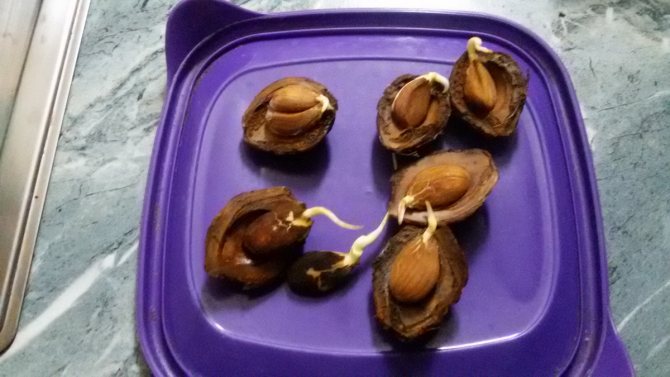

Planting peaches from the stone is done infrequently, since the overwhelming majority of amateur gardeners believe that only breeders and nursery workers are engaged in this business. However, it is not difficult to germinate peach pits if you follow agrotechnical standards. This method of reproduction of a fruiting culture has a lot of positive points, which are as follows:
- The peach, the seed of which will be germinated, has already been tasted and therefore the gardener knows what to expect from the future harvest.
- Competent reproduction helps you get the number of plants you need.
- The seedling comes out cheap, since you do not have to pay for the fact that someone has grown it.
- Own-rooted peach trees are a good base for grafting.
Preparing the pit and soil
You need to start preparing the soil by clearing the site. Remove debris and stones, collect fallen leaves, weed. Do this 2-3 months before the intended planting.
Then carefully dig up the ground several times, simultaneously removing pebbles and plant roots. This will give an additional effect - saturation of the soil with oxygen.
The next step is the landing pit. The minimum dimensions of the pit are 0.5 m in length, width and depth, but depending on the size of the seedling, it can go up to 1 x 1 x 0.8 m... High soil moisture can be neutralized by creating good drainage from expanded clay, pebbles, small fragments of bricks in the planting pit. In this case, the depth of the pit increases by 20 cm. Throw away the removed turf with roots of grass and weeds, and set aside about 20 cm of the upper fertile soil layer.
Mix the rest of the soil taken out of the pit with two buckets of humus (12-15 kg), and wood ash (0.5 kg). Then pour it onto the bottom of the hole so that an even cone about 2/3 of the hole is formed. Sprinkle it lightly with earth from the top layer and let it sit for 16–20 days.
The longer the pit will stand, the better the soil will be.
No other fertilization is required if you are planting a peach in black soil. In all other cases, they are needed.... Often planting a peach ends in failure due to a lack of humus, excess clay, soil salinity or peat formation.
Ideally, you need to conduct a soil analysis in order to clarify what kind of feeding the seedling will need, and begin to fill the lack of trace elements one year before the planned planting. In the process of planting, inorganic fertilizers and manure are highly discouraged: you will burn the roots of the seedling.
Table: preparing potting soil for planting a peach
| Soil type | Required Supplements |
| Leached chernozem |
|
| Heavy clay |
|
| Peat |
|
| Serozem | Complex mineral fertilizers (Ammophos, Universal, Kemira Lux) in the amount specified in the instructions. |
| Podzol |
|
| Podzolized |
|
Peach among fruit trees is the leader in the absorption of trace elements and nutrients. But if the pit is prepared correctly, taking into account the characteristics of the soil, next summer it will do without additional fertilizers.
Reproduction using seeds
Recently, the hobby for the cultivation of southern exotic trees at home has been gaining momentum. The beginning was laid by Pavlovsk lemons, which successfully bore fruit on the northern windowsills.
Over time, tangerines, grapefruits, and oranges joined lemons. Then came the turn of coffee, feijoa, papaya and pineapple. Peaches grow much closer to the middle lane than these exotics, which feel good in the house. Why not try to breed a peach at home.
Important! Of course, there are no special varieties of indoor peaches.
Although it is a short plant, it is still a tree. Therefore, it will not be possible to grow it in a pot. However, growing peaches through seedlings grown from seeds planted in pots is a very promising activity.
Helpful hints
As you can see, it is absolutely possible to grow a peach tree from a stone at home, but whether it is worth doing and whether it is possible to get a high-quality culture seedling in this way, for the most part, depends on compliance with all the requirements for the procedure for planting and caring for the seeds.
In addition, it is worth taking advantage of the recommendations of experienced growers already at the stage of choosing a suitable seed material.
Also read how to grow an apricot tree, cherries, cherries, plums, apple trees and grapes from seeds at home.
The main recommendations in this case include the following tips:
- Always carefully select the tree from which the planting material will be obtained. It is desirable that the selected plant be self-rooted, and not grafted, since the latter options are often sterile.
- You should not harvest peach seeds purchased at the store, as there is no guarantee that the subsequent harvest will at least approximately correspond to what you bought (if the seeds will germinate at all in your climatic conditions).
- It is necessary to collect fruits for harvesting their seeds closer to the end of summer, so that the harvest has time to ripen well, and the fruits become as large, ripe and healthy as possible (any signs of rot, insect activity or mechanical damage should be absent).
- The selected seeds should not have cracks or be too light, since the germination of such planting material is extremely difficult to guarantee.
Otherwise, observing the rules for pre-planting seed processing and adhering to the instructions for planting them in closed soil with further appropriate care, there should be no problems with obtaining a new plant, and very soon it will be possible to transplant a young peach into the garden.
How to shape correctly
Formative pruning is carried out in early spring, before the leaves bloom, and sanitary pruning - in the fall, after leaf fall. The crown of the tree is formed in the form of a bowl. In the first year, only the top of the tree is cut. On the second, 2 branches are left on the sides, the rest are cut off. They are also slightly shortened.
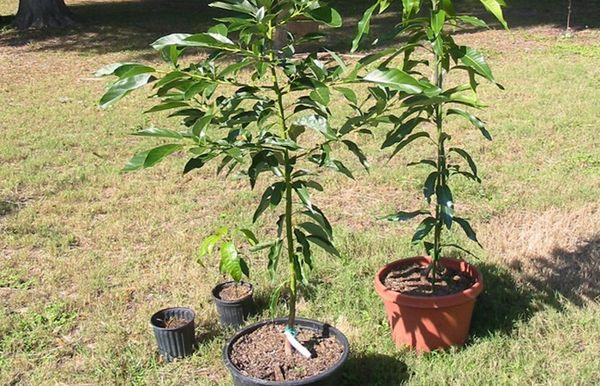

With the subsequent pruning, it must be remembered that the peach bears fruit only on the growths of the last year. The branches must be cut to a replacement knot. Tops and shoots thickening the crown must be removed.
Peach varieties
Tomato Peach
According to the ripening rate, peaches are divided into early, mid and late ripening. All three varieties are well grown in the southern region. In the middle lane and the northern region, early varieties are often used, less often medium ones.
For the following varieties of culture are most suitable for the southern regions:
- Rossoshanskaya early ripening;
- Favorite;
- Kiev early;
- Reliable;
- Cardinal;
- Fluffy early and others;


Southern variety of peach "Cardinal"
IN winter-hardy varieties are grown in the middle lane, such as:
- Veteran;
- Kremlin large-fruited;
- Sunset;
- Fairy tale, etc.


Winter-hardy peach variety "Veteran"
Every year more and more new varieties of peach trees appear on the market. Therefore, choosing the right variety for the region where you plan to plant a peach will not be difficult.
Recommended neighbors for culture
Bad neighbors are not only behind the next wall in a hammer drill, but also in fruit trees. When planting trees in the garden, it is important to respect the recommended neighborhood between certain crops. This is due to the fact that unfavorable neighbors can weaken the tree, its immunity, and significantly reduce the amount of harvest.
Neighbors unfavorable for peach:
- Walnut;
- pear;
- cherry;
- Apple tree;
- apricot;
- sweet cherry.
Perfect time to board
Planting peach trees can only be carried out after they have passed into a dormant period. Look for varieties that are ideal for growing in the climate of your area.
Dates of planting peach in autumn in different regions and countries
Between September 5 and 15, it is recommended to plant trees in the southern territories of Russia, including in the northwestern and northeastern parts of Ukraine. Also by choosing this time, the tree gets enough time to root before frost.
On the territory of the Krasnodar Territory, Crimea, the southern part of Ukraine, including Transcarpathia, it is recommended to land no later than October 20. If winter comes late, planting can be postponed to the first half of November, but not later.
In areas with a temperate climate, if the tree does not die in winter and endures frost, it will most likely not bear fruit in the first year. However, this factor is greatly influenced by the regularity and correctness of care. Be sure to bear fruit only those trees that grow in greenhouses and greenhouses.
Peach sprout care
Land
The most favorable soil for the growth and successful development of peach sprouts is light, loose, fertile. It can be composed of two parts of leaf (garden) land, one part of peat, part of humus (greenhouse land) and part of sand (agroperlite).
Temperature
Normal room temperature is fine. But you should avoid sudden changes in temperature and cold drafts.
Lighting
Young seedlings require maximum light, but without direct sunlight. If there is not enough light, which is important for winter and early spring, provide artificial illumination with phytolamps or white fluorescent lamps.
Watering
Water the peach sprouts regularly, but in moderation.
Seedling care at home
Provide seedlings with conditions as close to natural as possible. Keep them on the lightest and warmest windowsill; on fine days, open the whole window. A temperature difference is required: during the day - from 23 ° C to 30 ° C, at night - 18 ... 20 ° C. Do not turn the seedlings against the glass in different directions, do not rearrange them from place to place. Use a marker to mark the side of the pot that faces the light. Always maintain this position, and when planting in the ground, orient the seedling with the marked side to the south.
The rest of the home care:
- watering as the earth dries up;
- feeding once every 10 days with a complex mixture of Fertika Lux;
- timely detection of pests, diseases and control of them.

